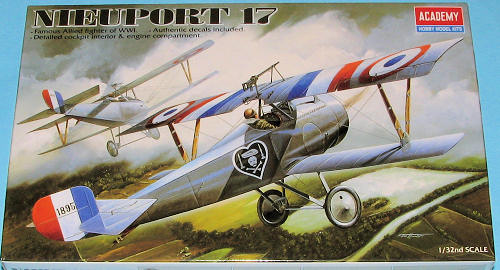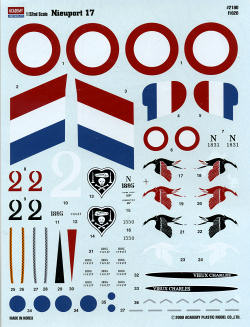
Academy 1/32 Nieuport 17
| KIT #: | 2190 |
| PRICE: | $19.00 MSRP |
| DECALS: | Two options |
| REVIEWER: | Scott Van Aken |
| NOTES: | Includes thread for rigging |

| HISTORY |
The Nieuport 17 reached the French front in March 1916, and quickly began to replace the Nieuport 11 in French service. It was also ordered by the Royal Flying Corps and Royal Naval Air Service, as it was superior to any British fighter at that time. Worthy of note is the fact that during part of 1916, the Nieuport 17 equipped every fighter squadron of the Aviation Militaire. The Germans supplied captured examples to several of their aircraft manufacturers for them to copy. This resulted in the Siemens-Schuckert D.I which, apart from the engine installation, was a close copy and actually went into production, although in the event it was not used operationally on the Western Front.
By early 1917, the Nieuport was outclassed in most respects by the latest German fighters. Newer models (the Nieuport 24 and the 27) were brought out in an attempt to retain the type's ascendency. However, the SPAD S.VII had already replaced the Nieuport fighters in many French squadrons by mid-1917. The British persisted with Nieuports a little longer, not replacing their last Nieuport 24bis until early 1918.
Many Entente air aces flew Nieuport fighters, including Canadian ace W.A. Bishop, who received a Victoria Cross while flying it, and most famously of all, Albert Ball.
Like the other Nieuport types, the 17 was used as an advanced trainer for prospective fighter pilots after its operational days were over.
| THE KIT |
 I'm not sure if this is an ex-Hobbycraft kit or not, but suspect that it might be. Regardless, the kit itself is very nicely molded and while some may think the fabric presentation is too much 'hills and valleys', it looks quite acceptable to me.
I'm not sure if this is an ex-Hobbycraft kit or not, but suspect that it might be. Regardless, the kit itself is very nicely molded and while some may think the fabric presentation is too much 'hills and valleys', it looks quite acceptable to me.
These kits are by no means complex, but neither were the real planes. There is a nicely done interior with control stick and rudder pedals. A nicely molded rotary is also part of the deal and the the machine gun is well formed.
The kit parts already have the rigging holes drilled out and while they look a bit large to me, this is probably to match the thread that is included. Some of you will want to replace the thread with something else, such as wire. Much space in the instructions is taken up with rigging the model. They suggest cutting small lengths of stretched sprue, tying the thread around it and then weaving the thread through the various holes in the fuselage prior to assembly. For the rest of the rigging where there is no 'interior' to attach thread (like the wings), it is a point A to B sort of deal and how you'll get the thread taught is beyond me. Of course, you realize that many modelers will drill holes through the airfoils, attach the thread and then fill and sand the visible sections.
'interior' to attach thread (like the wings), it is a point A to B sort of deal and how you'll get the thread taught is beyond me. Of course, you realize that many modelers will drill holes through the airfoils, attach the thread and then fill and sand the visible sections.
Markings are for two planes. Both are in overall aluminum finish for the fuselage and tailplanes. nugesser's plane as shown on the box art, also has aluminum wings, while Guynemer's plane has camouflaged upper surfaces to the wings. Guynemer's aircraft also has several optional 'stork' markings for the side. Guess that the exact colors are in dispute so several are provided. Academy decals are generally pretty good and there are aftermarket for those seeking them.
| CONCLUSIONS |
So, here is an opportunity to build a 1/32 WWI biplane that has sufficient rigging to look the part and won't cost you $65.
| REFERENCES |
http://en wikipedia.org
February 2009
Thanks to me for this one.
If you would like your product reviewed fairly and fairly quickly, please contact the editor or see other details in the